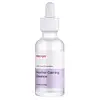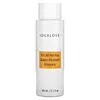What's inside
What's inside
 Key Ingredients
Key Ingredients

 Benefits
Benefits

 Concerns
Concerns

No concerns
 Ingredients Side-by-side
Ingredients Side-by-side

Calluna Vulgaris Extract 85%
Skin ConditioningGlycerin
HumectantButylene Glycol
HumectantErythritol
HumectantRutin
AntioxidantAllantoin
Skin ConditioningAspalathus Linearis Leaf Extract
Skin ConditioningSodium Hyaluronate
HumectantAureobasidium Pullulans Ferment
Skin ConditioningChrysanthemum Indicum Flower Extract
Skin ConditioningChlamydomonas Extract
Skin ConditioningChitosan
Lactobacillus Ferment
Skin ConditioningLeuconostoc/Radish Root Ferment Filtrate
AntimicrobialPanthenol
Skin ConditioningTrehalose
HumectantBeta-Glucan
Skin ConditioningCholesterol
EmollientCeramide NP
Skin ConditioningGlycereth-26
HumectantPentylene Glycol
Skin ConditioningAmmonium Acryloyldimethyltaurate/Vp Copolymer
Diethoxyethyl Succinate
SolventPropanediol
SolventDipotassium Glycyrrhizate
HumectantSuccinic Acid
BufferingTromethamine
Buffering1,2-Hexanediol
Skin ConditioningEthylhexylglycerin
Skin ConditioningXylitol
HumectantWater
Skin ConditioningBiosaccharide Gum-4
Skin ConditioningDipropylene Glycol
HumectantTocopherol
AntioxidantHydrogenated Lecithin
EmulsifyingCalluna Vulgaris Extract 85%, Glycerin, Butylene Glycol, Erythritol, Rutin, Allantoin, Aspalathus Linearis Leaf Extract, Sodium Hyaluronate, Aureobasidium Pullulans Ferment, Chrysanthemum Indicum Flower Extract, Chlamydomonas Extract, Chitosan, Lactobacillus Ferment, Leuconostoc/Radish Root Ferment Filtrate, Panthenol, Trehalose, Beta-Glucan, Cholesterol, Ceramide NP, Glycereth-26, Pentylene Glycol, Ammonium Acryloyldimethyltaurate/Vp Copolymer, Diethoxyethyl Succinate, Propanediol, Dipotassium Glycyrrhizate, Succinic Acid, Tromethamine, 1,2-Hexanediol, Ethylhexylglycerin, Xylitol, Water, Biosaccharide Gum-4, Dipropylene Glycol, Tocopherol, Hydrogenated Lecithin
Galactomyces Ferment Filtrate
HumectantWater
Skin ConditioningButylene Glycol
HumectantPentylene Glycol
Skin Conditioning1,2-Hexanediol
Skin ConditioningBifida Ferment Lysate
Skin ConditioningLactobacillus Ferment
Skin ConditioningTripeptide-1
Skin ConditioningPalmitoyl Tripeptide-1
Skin ConditioningPalmitoyl Pentapeptide-4
Skin ConditioningHexapeptide-9
Skin ConditioningHexapeptide-11
Skin ConditioningCopper Tripeptide-1
Skin ConditioningSoluble Proteoglycan
Skin ConditioningPolygonum Cuspidatum Root Extract
AntioxidantCentella Asiatica Extract
CleansingScutellaria Baicalensis Root Extract
AstringentSodium Hyaluronate
HumectantGlycyrrhiza Glabra Root Extract
BleachingCamellia Sinensis Leaf Extract
AntimicrobialPanthenol
Skin ConditioningCeramide Ns
Skin ConditioningCeramide As
Skin ConditioningCeramide AP
Skin ConditioningCeramide NP
Skin ConditioningCeramide EOP
Skin ConditioningBetaine
HumectantPropanediol
SolventAllantoin
Skin ConditioningAdenosine
Skin ConditioningHydrogenated Lecithin
EmulsifyingRosmarinus Officinalis Leaf Extract
AntimicrobialChamomilla Recutita Flower Extract
MaskingPhytosphingosine
Skin ConditioningCholesterol
EmollientGlycerin
HumectantCetearyl Alcohol
EmollientStearic Acid
CleansingPolyglyceryl-10 Laurate
Skin ConditioningXanthan Gum
EmulsifyingCaprylyl Glycol
EmollientGalactomyces Ferment Filtrate, Water, Butylene Glycol, Pentylene Glycol, 1,2-Hexanediol, Bifida Ferment Lysate, Lactobacillus Ferment, Tripeptide-1, Palmitoyl Tripeptide-1, Palmitoyl Pentapeptide-4, Hexapeptide-9, Hexapeptide-11, Copper Tripeptide-1, Soluble Proteoglycan, Polygonum Cuspidatum Root Extract, Centella Asiatica Extract, Scutellaria Baicalensis Root Extract, Sodium Hyaluronate, Glycyrrhiza Glabra Root Extract, Camellia Sinensis Leaf Extract, Panthenol, Ceramide Ns, Ceramide As, Ceramide AP, Ceramide NP, Ceramide EOP, Betaine, Propanediol, Allantoin, Adenosine, Hydrogenated Lecithin, Rosmarinus Officinalis Leaf Extract, Chamomilla Recutita Flower Extract, Phytosphingosine, Cholesterol, Glycerin, Cetearyl Alcohol, Stearic Acid, Polyglyceryl-10 Laurate, Xanthan Gum, Caprylyl Glycol
 Reviews
Reviews

Ingredients Explained
These ingredients are found in both products.
Ingredients higher up in an ingredient list are typically present in a larger amount.
1,2-Hexanediol is a synthetic liquid and another multi-functional powerhouse.
It is a:
- Humectant, drawing moisture into the skin
- Emollient, helping to soften skin
- Solvent, dispersing and stabilizing formulas
- Preservative booster, enhancing the antimicrobial activity of other preservatives
Allantoin is a soothing ingredient known for its protective and moisturizingg properties. Because of this, it is often added to products with strong active ingredients.
Studies show higher concentrations of this ingredient can promote wound healing.
Though it can be derived from the comfrey plant, allantoin is produced synthetically for cosmetic products to ensure purity.
Learn more about AllantoinButylene Glycol (or BG) is used within cosmetic products for a few different reasons:
Overall, Butylene Glycol is a safe and well-rounded ingredient that works well with other ingredients.
Though this ingredient works well with most skin types, some people with sensitive skin may experience a reaction such as allergic rashes, closed comedones, or itchiness.
Learn more about Butylene GlycolCeramide NP is a type of ceramide and formally known as ceramide 3.
Ceramides are intercellular lipids naturally found in our skin that bonds dead skin cells together to create a barrier. They are known for their ability to hold water and thus are a great ingredient for dry skin.
Ceramides are an important building block for our skin barrier. A stronger barrier helps the skin look more firm and hydrated. By bolstering the skin ceramides act as a barrier against irritating ingredients. This can help with inflammation as well.
If you would like to eat ceramides, sweet potatoes contain a small amount.
Read more about other common types of ceramides here:
Ceramide AP
Ceramide EOP
Cholesterol is a class of organic molecules called lipids. It helps hydrate your skin and is essential to having a healthy skin barrier.
Our skin naturally contains cholesterol in the outermost layer. Besides cholesterol, it also contains ceramides and fatty acids. Cholesterol makes up about 1/4 of your skin's outer layer and barrier. Your skin barrier is responsible for keeping allergens and microbes out. Having a healthy skin barrier is also responsible for keeping your skin firm and plump.
Our bodies use cholestrol to create vitamin D, steroid hormones, and more.
Learn more about CholesterolGlycerin is already naturally found in your skin. It helps moisturize and protect your skin.
A study from 2016 found glycerin to be more effective as a humectant than AHAs and hyaluronic acid.
As a humectant, it helps the skin stay hydrated by pulling moisture to your skin. The low molecular weight of glycerin allows it to pull moisture into the deeper layers of your skin.
Hydrated skin improves your skin barrier; Your skin barrier helps protect against irritants and bacteria.
Glycerin has also been found to have antimicrobial and antiviral properties. Due to these properties, glycerin is often used in wound and burn treatments.
In cosmetics, glycerin is usually derived from plants such as soybean or palm. However, it can also be sourced from animals, such as tallow or animal fat.
This ingredient is organic, colorless, odorless, and non-toxic.
Glycerin is the name for this ingredient in American English. British English uses Glycerol/Glycerine.
Learn more about GlycerinHydrogenated Lecithin is created from the hydrogenation of lecithin (a group of phospholipids). Hydrogenation is a chemical reaction between hydrogen and another element.
This ingredient is an emollient and emulsifier. As an emollient, it helps soften skin by trapping moisture within. As an emulsifier, it prevents oil and water ingredients from separating.
Lactobacillus Ferment is created by fermenting the Lactobacillus bacteria. It helps keep our skin's natural barrier and microbiome healthy.
Studies show lactobacillus ferment to be effective at repairing the skin barrier. Having a healthy skin barrier helps keep your skin healthy and hydrated. It also protects against bad bacteria.
As a probiotic/prebiotic/postbiotic, Lactobacillus ferment can help regular our natural biome. In fact, one study found a lack of diversity in our natural skin biome can trigger acne.
Learn more about Lactobacillus FermentPanthenol is a common ingredient that helps hydrate and soothe the skin. It is found naturally in our skin and hair.
There are two forms of panthenol: D and L.
D-panthenol is also known as dexpanthenol. Most cosmetics use dexpanthenol or a mixture of D and L-panthenol.
Panthenol is famous due to its ability to go deeper into the skin's layers. Using this ingredient has numerous pros (and no cons):
Like hyaluronic acid, panthenol is a humectant. Humectants are able to bind and hold large amounts of water to keep skin hydrated.
This ingredient works well for wound healing. It works by increasing tissue in the wound and helps close open wounds.
Once oxidized, panthenol converts to pantothenic acid. Panthothenic acid is found in all living cells.
This ingredient is also referred to as pro-vitamin B5.
Learn more about PanthenolPentylene glycol is typically used within a product to thicken it. It also adds a smooth, soft, and moisturizing feel to the product. It is naturally found in plants such as sugar beets.
The hydrophilic trait of Pentylene Glycol makes it a humectant. As a humectant, Pentylene Glycol helps draw moisture from the air to your skin. This can help keep your skin hydrated.
This property also makes Pentylene Glycol a great texture enhancer. It can also help thicken or stabilize a product.
Pentylene Glycol also acts as a mild preservative and helps to keep a product microbe-free.
Some people may experience mild eye and skin irritation from Pentylene Glycol. We always recommend speaking with a professional about using this ingredient in your routine.
Pentylene Glycol has a low molecular weight and is part of the 1,2-glycol family.
Learn more about Pentylene GlycolPropanediol is an all-star ingredient. It softens, hydrates, and smooths the skin.
It’s often used to:
Propanediol is not likely to cause sensitivity and considered safe to use. It is derived from corn or petroleum with a clear color and no scent.
Learn more about PropanediolSodium Hyaluronate is hyaluronic acid's salt form. It is commonly derived from the sodium salt of hyaluronic acid.
Like hyaluronic acid, it is great at holding water and acts as a humectant. This makes it a great skin hydrating ingredient.
Sodium Hyaluronate is naturally occurring in our bodies and is mostly found in eye fluid and joints.
These are some other common types of Hyaluronic Acid:
Learn more about Sodium HyaluronateWater. It's the most common cosmetic ingredient of all. You'll usually see it at the top of ingredient lists, meaning that it makes up the largest part of the product.
So why is it so popular? Water most often acts as a solvent - this means that it helps dissolve other ingredients into the formulation.
You'll also recognize water as that liquid we all need to stay alive. If you see this, drink a glass of water. Stay hydrated!
Learn more about Water